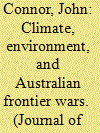| Srl | Item |
| 1 |
ID:
155725


|
|
|
|
|
| Summary/Abstract |
Although bound together by geographical location, historic ties, and cultural affinity, Australia and New Zealand have often had a fraught relationship. Participation in a British security framework mitigated the effects of the imbalance in size between the two countries. But New Zealand’s efforts to assert itself within this system encouraged a competition in patriotism with Australia over commitments to wars up to the Korean War. When the British framework weakened, New Zealand hesitated to seek a similar status within its alliance with the United States. Far from competing with Australia, it resisted pressure to commit troops to the U.S.-led effort in South Vietnam, only to find itself increasingly being dragged along by its trans-Tasman neighbor.
|
|
|
|
|
|
|
|
|
|
|
|
|
|
|
|
| 2 |
ID:
155721


|
|
|
|
|
| Summary/Abstract |
From the establishment of the colony of New South Wales at Sydney in 1788, British soldiers and settlers fought a series of wars against Australian Aboriginal warriors to occupy land for farming and grazing. Rainfall in Australia is highly variable due to the influence of five external climate drivers, including the El Niño Southern Oscillation. This article argues there is a strong correlation between the onset of drought in the inland region of south-eastern Australia and the outbreak of armed conflict in the period from 1824 to 1841. This article argues that this approach of comparing climate data and records of conflicts can be extended to other regions and time periods in Australia, and in other regions of the world affected by similar climate drivers.
|
|
|
|
|
|
|
|
|
|
|
|
|
|
|
|
| 3 |
ID:
155724


|
|
|
|
|
| Summary/Abstract |
As with most U.S. submarine operations in the Atlantic during the Second World War, those off the Panama Canal have been ignored by historians. This is not difficult to understand given that the main battles fought by submariners in the Canal Zone, as documented here, were against the deficiencies of their boats rather than the enemy. Despite the undoubted importance of the Canal to the war effort, the heavy demands for U.S. submarines elsewhere meant that those boats assigned to Coco Solo tended to be the most decrepit. While submarine patrols off the Panama Canal may have contributed to a greater sense of security, they contributed little tangible against the enemy. Nevertheless, these patrols helped to train significant numbers of men for the burgeoning submarine service and laid the groundwork for the later success of some submarine commanders. By highlighting some of the shortcomings of air patrols off the Canal, they possibly contributed to more effective air defences as well.
|
|
|
|
|
|
|
|
|
|
|
|
|
|
|
|
| 4 |
ID:
155726


|
|
|
|
|
| Summary/Abstract |
Scholarly soldiers are rare in Australia, but not totally absent. Following World War II, Eustace Graham Keogh made a significant contribution to Australian military literature as the founding editor of the Australian Army Journal. He also authored a series of campaign studies used in officer promotion examinations. Keogh’s contributions to professional education and military history in Australia have, until recently, been forgotten. This paper provides a sketch of his career and an assessment of his role in the intellectual history of the Australian Army in the immediate postwar period, a time when the Army was undergoing momentous change.
|
|
|
|
|
|
|
|
|
|
|
|
|
|
|
|
| 5 |
ID:
155728


|
|
|
| 6 |
ID:
155722


|
|
|
|
|
| Summary/Abstract |
This article examines the command of the 22nd Australian Infantry Battalion during the 1918 Hundred Days campaign of the First World War as a means both to explore the nature of decentralised command at battalion level and to demonstrate what can be gained by exploring an understudied level of the army’s organisation. It explores the degree to which “command and control” was delegated to the battalion commander for planning and executing operations. The article demonstrates how decentralised command and control functioned in late 1918, as a moderately successful if awkward and inconsistent process.
|
|
|
|
|
|
|
|
|
|
|
|
|
|
|
|